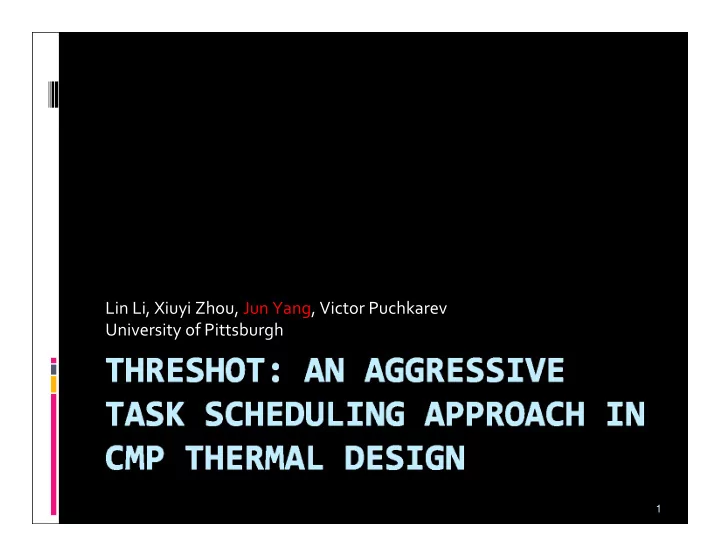

Lin Li, Xiuyi Zhou, Jun Yang, Victor Puchkarev University of Pittsburgh 1
Outline � Introduction � ThresHot Algorithm � Experiment and Results � Conclusion 2
Thermal Management is Critical � Technology ↓ → Power Density ↑ � Temperature ↑ � Circuit performance ↓ E A � Reliability ↓ = × kT MTTF C e � Thermal runaway T ↑ → P leakage ↑ → P total ↑ � Packaging and cooling cost ↑ 3
Task Scheduling Can Help � Conventionally � Performance throttling, e.g. DVFS � Our objective � Preserve performance – ↓ DVFS � Rationale � Workloads stress processor differently in space and time � Approach � Find a good schedule of workloads to keep temperature low 4
Task Scheduling Trade ‐ offs � Pros: � No need to change hardware � Flexible: scheduling algorithm can be changed in OS � Cons: � Scheduling overhead � Lack accurate hardware details 5
Task Scheduling Algorithms � Objective: Reduce thermal emergencies � Improve performance � Improve reliability � Naïve scheduling algorithms � Random � Round ‐ Robin � Power balancing 6
Outline � Introduction � ThresHot Algorithm � Experiment and Results � Conclusion 7
Temperature Slack � Temporal temperature slack in a single processor � Task scheduling can reduce thermal emergencies [Yang et al. ISPASS 2008] � Spatial and temporal temperature slack in CMP � How to schedule tasks to minimize total thermal emergencies? 8
Thermal Model � Han, Koren, Krishna, “TILTS: A Fast Architectural ‐ Level Transient Thermal Simulation Method,” J. of Low Power Electronics , 2007. T( n ) = AT( n-1 ) + BP( n-1 ) 9
Understanding the Model 1 � AT( n ‐ 1 ) describes the temperature drop at time n , if there is no power � Available temperature slacks formed 10
Understanding the Model 2 � BP( n ‐ 1 ) describes the temperature increase due to injected power of different tasks � Task scheduling is to find a mapping between these increases and the thermal slacks. 11
Fast Temperature Calculation � Temperature rises due to power hardly change from core to core � Calculate AT(n ‐ 1) and BP(n ‐ 1) once → T(n) for all possible schedule AT( n-1 ) BP( n-1 ) 12
TSM: Temperature Slack Matrix Tasks 2 3 4 1 + Core 1 - 2 3 4 13
Scheduling Hot Hazard Tasks DVFS-on Temperature …… DVFS-off Temperature c 4 c 3 c 2 c 1 n t n-1 � Hot hazard jobs � Too hot even on the coolest core � Decision: Map it to the coolest core � Minimize DVFS penalty in the current scheduling cycle 14
Scheduling Mild Tasks DVFS-on Temperature DVFS-off Temperature J 2 Not exceeding threshold c 4 J 3 Reserve cool core resource J 1 c 2 c 1 J 4 c 3 n t n-1 � Mild jobs � A schedule can be found w/o DVFS � Goal is not to average the temperature � Rather, reserve cool core resources for hot hazard tasks in the future 15
ThresHot Scheduling with TSM Tasks 2 3 4 1 0.415 8.973 -7.617 12.322 Core 1 0.773 9.285 -7.259 12.635 2 0.524 10.158 -7.507 16.503 3 0.857 9.407 -7.175 12.975 4 ∑ 2.569 37.823 -29.558 54.435 16
Outline � Introduction � ThresHot Algorithm � Experiment and Results � Conclusion 17
Experiment Methodology � Thermal model: HotSpot 4.0 + TILTS � Power trace � Running real SPEC2K benchmarks � Extracted from performance counter � Hardware DVFS: � Triggered on/off at 86.5/85.5 � Frequency scaling: 0.7 � Voltage scaling: 0.92 � DTM triggering overhead: 30 us � Schedule interval: 8ms 18
Experiment Methodology � Quad core floorplan based on P4 Northwood: 93 function units with shared L2 cache 19
Performance Comparison • ThresHot minimizes thermal emergencies to mitigate the performance loss from DVFS • 13% and 6% reduction in performance penalty over “Base” and “Balancing” 20
Reliability Comparison <10 ° C [10 ° C~15 [15 ° C~20 >20 ° C Algorithm ° C] ° C] Baseline 99.91 0.07 0.02 0.01 Random 97.45 1.55 0.68 0.32 Balancing 95.50 2.67 1.23 0.60 RR-1 95.83 2.60 1.05 0.52 RR-2 96.91 1.93 0.78 0.38 ThresHot 98.22 1.21 0.43 0.14 � Thermal cyclings caused by the significant temperature variations are minimal in ThresHot 21
Thermal Behavior Comparison Baseline RR Balancing ThresHot 22
Conclusion � ThresHot algorithm does better than RR and Balancing in reducing thermal emergencies, and thermal cyclings � ThresHot improves the performance in penalized time period by 13% and 6% compared to Baseline and Balancing � Function unit level thermal control 23
24
Recommend
More recommend